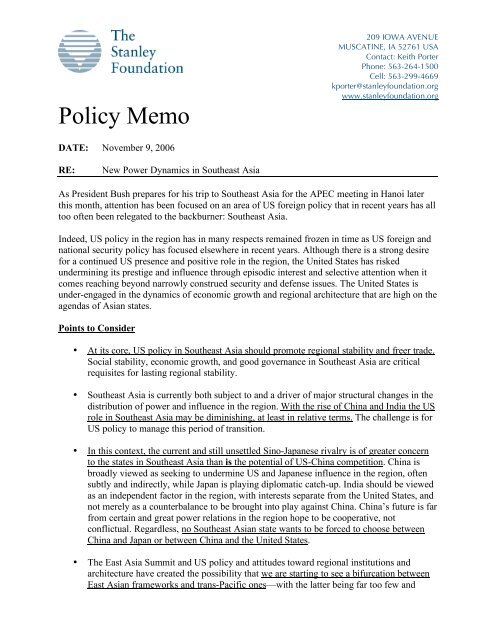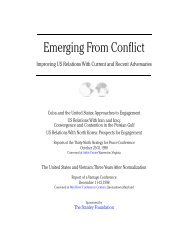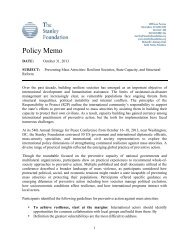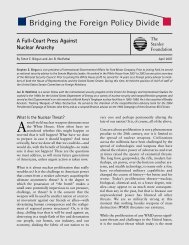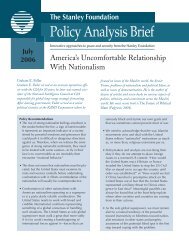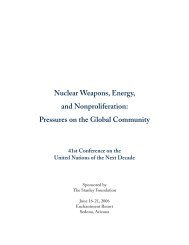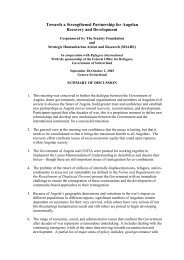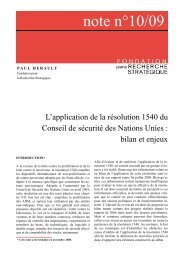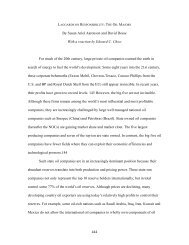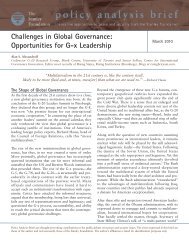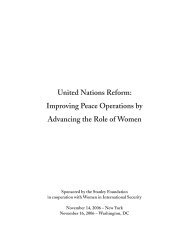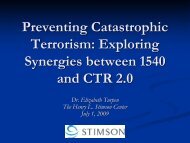Policy Memo - The Stanley Foundation
Policy Memo - The Stanley Foundation
Policy Memo - The Stanley Foundation
- No tags were found...
Create successful ePaper yourself
Turn your PDF publications into a flip-book with our unique Google optimized e-Paper software.
weak. East Asian institutions may also be structurally light, meet far too often, and talktoo much, at least relative to substantial action. But there is value in “just talking,” giventhe alternatives, and there has been a strong and positive correlation between the rise ofEast Asia’s “talk shops” and interstate peace in region.• <strong>The</strong>re is increasing evidence of the influence of politics and events in the Middle East inshaping Southeast Asian perceptions. <strong>The</strong> potentials for reconstructing Muslim identity inSoutheast Asia, if and how that unfolds, may become a problem for the United Statesinsofar as the United States is perceived as anti-Islam. In the light of regional anger overthe recent war in Lebanon, more intense even than Southeast Asian criticism of the war inIraq, the United States should not underestimate the potential “soft power” of Islam as anidentity.Recommendations• <strong>The</strong> United States needs to address perceptions in Southeast Asia—reflected in numerouspublic opinion polls—that it is unilateralist and self-serving. One possible response wouldbe to enter into a broader dialogue on US policy toward the Middle East.• <strong>The</strong> United States should pursue policy initiatives in the region through multilateral forabut must also work in bilateral settings. Initiatives on key issues like avian flu can senda message that the United States is engaged in the region.• US policy initiatives must embody a long-term commitment to Southeast Asia andaddress regional and local problems in the region where and as they are. For example,having pressed the Laotian government to eliminate opium production and trafficking,the United States must not leave it at that. <strong>The</strong> United States needs to follow throughand work with the Laotian government to address economic dislocations anddisplacement. Likewise, an ongoing commitment to the justice and reconciliationprocess in Cambodia can help reinforce the message that the United States has notturned away from human rights in the region post-9/11.Security• <strong>The</strong> United States should focus less on traditional security issues such as SLOCs andthe maintenance of its air and sea capabilities and thus avoid a purely military focus onand in the region. While these issues are important, the United States should focus moreon nontraditional challenges such as terrorism, maritime security, trafficking (of arms,narcotics, and people), health issues (such as pandemics), and the environment.• Military-to-military relations are viewed today as less important in Southeast Asia,where the focus is on economics and trade. While the United States should continue todevelop these relations and programs, they should be weighted accordingly. <strong>The</strong> UnitedStates should look for ways to expand military-to-military interactions throughpeacekeeping exercises, natural disaster training, and humanitarian relief efforts.• <strong>The</strong> United States should continue transparently to review its military presence in theregion, with the aim of reducing its footprint while increasing its capabilities. <strong>The</strong>United States should upgrade defense cooperation with friends and allies in the region,including exercises such as Cobra Gold.2
Regional Architecture• <strong>The</strong> United States was “absent at creation” of the East Asia Summit (EAS) in KualaLumpur and has been likewise absent, or distracted, in its conduct of regionaldiplomacy in recent years. Although the EAS accomplished little, the United Statesshould not stand idly by as these regional institutional processes develop. <strong>The</strong> US needsto be engaged to assure enduring trans-Pacific linkages.• To that end, the United States should take advantage of opportunities for engagementwith and in regional or international institutions when doing so could improveAmerica’s legitimacy and leverage. Accordingly, the United States should accede, insome form, to the Treaty of Amity and Cooperation, and thus participate in the EAS,support institutionalizing the ASEAN Regional Forum (ARF) through the formation ofa separate secretariat, and make the prospective US Ambassadorship to ASEAN a fulltimejob rather than a second hat for a Deputy Assistant Secretary of State to wear. <strong>The</strong>United States should also support back-to-back meetings of ARF and the Asia PacificEconomic Cooperation (APEC) forum meetings and other mechanisms to furtherlinkages within Southeast Asia and between the region and the United States.Domestic Environments• Although views within ASEAN have been changing in recent years, there is a gulfbetween the United States and many of the states in the region on issues of “noninterference”in domestic matters. For example, the so-called “Beijing Consensus,” withits steadfast support for sovereignty, is seen as representing an organic outgrowth ofthinking in the region, while the “Washington Consensus,” which holds that the natureof transnational threats requires that nations take a proactive approach when a country’sbehavior affects its neighbors, is not.• <strong>The</strong>re is no convincing evidence that a window of opportunity for change in Burmaexists. China has not shown that it will use its leverage to improve political conditionsin Burma. Indeed, nascent India-China competition for natural resources might giveBurma additional leverage. <strong>The</strong> United States should nevertheless continue toencourage efforts for change in Burma, within the country and in international fora.Economy• On the economic front the United States has a wide array of tools at its disposal,including ideas and resources for development, education, and investment, and foraddressing issues such as trade and immigration. <strong>The</strong> United States should takeadvantage of these tools and use them in a pragmatic and directed fashion to enhanceAmerican engagement in the region and thus bolster the health and vibrancy of the USand Southeast Asian economies. While Doha and the Trade Promotion Authority areimportant, the future of both remains cloudy and uncertain and, in that context, theUnited States should therefore consider complementary trade agreements, perhaps alongthe APEC sectoral model, as well as ways to increase American trade capacity andassistance, including better interagency coordination to these ends.• <strong>The</strong> United States should apply lessons learned from the 1997 financial crisis by makingmore appropriate financial advice available to policymakers in Southeast Asia, extending3
the Generalized System of Preferences to include lower-income countries, and taking fulladvantage of ASEAN and APEC—and the potentials for leverage offered by the AsianDevelopment Bank and the World Bank—to pursue a forward-looking approach to freetrade and economic development in the region.• <strong>The</strong> United States should promote sustainable development, and therefore focusespecially on reducing rural poverty, supporting environmentally sound infrastructureprojects, and encouraging government and private sector partnerships, for example, inmicrofinance.This policy memo provides top-line results of the major trends, challenges, and policyrecommendations intended for US policy in Southeast Asia developed at the <strong>Stanley</strong><strong>Foundation</strong>'s 47th annual Strategy for Peace Conference held October 19-21, 2006, at AirlieCenter in Warrenton, Virginia.<strong>The</strong> conference discussion groups were:o Domestic Determinants: Changing Asia-Pacific Societies and Foreign <strong>Policy</strong>(chaired by Catharin Dalpino, Georgetown University)o Means and Ends: Regional Frameworks in the Asia-Pacific (chaired by DonaldEmmerson, Stanford University)o Trade, Aid, and Investment: Economic Rivalry in the Asia-Pacific Arena (chairedby Lionel Johnson, Citigroup)o Allies, Friends, and “Strategic Competitors”: New Security Dynamics in theAsia-Pacific Region (chaired by Barry Desker, Institute for Defense and StrategicStudies, Singapore)All conference chairs as well as Project Chair Catharin Dalpino and Project DirectorMichael Schiffer are available for comment. Contact Keith Porter (563-299-4669) orMichael Schiffer (563-264-1500) for details.<strong>The</strong> conference, “New Power Dynamics in Southeast Asia,” was the first event in the <strong>Stanley</strong><strong>Foundation</strong>'s multiyear programming initiative on Southeast Asia that will include meetingsin Indonesia, Cambodia, Singapore, China, and the United States. <strong>The</strong> analysis andrecommendations included in this memo do not necessarily reflect the views of the <strong>Stanley</strong><strong>Foundation</strong> or any of the conference participants, but rather draw upon the major strands ofdiscussion put forward at the Airlie conference.For additional reports, policy briefs, and other information visit our Web site atwww.stanleyfoundation.org.<strong>The</strong> <strong>Stanley</strong> <strong>Foundation</strong> brings fresh voices, original ideas, and lasting solutions to debateson global and regional problems. It is a nonpartisan, private operating foundation, located inMuscatine, Iowa, that focuses on peace and security issues and advocates principledmultilateralism.4


